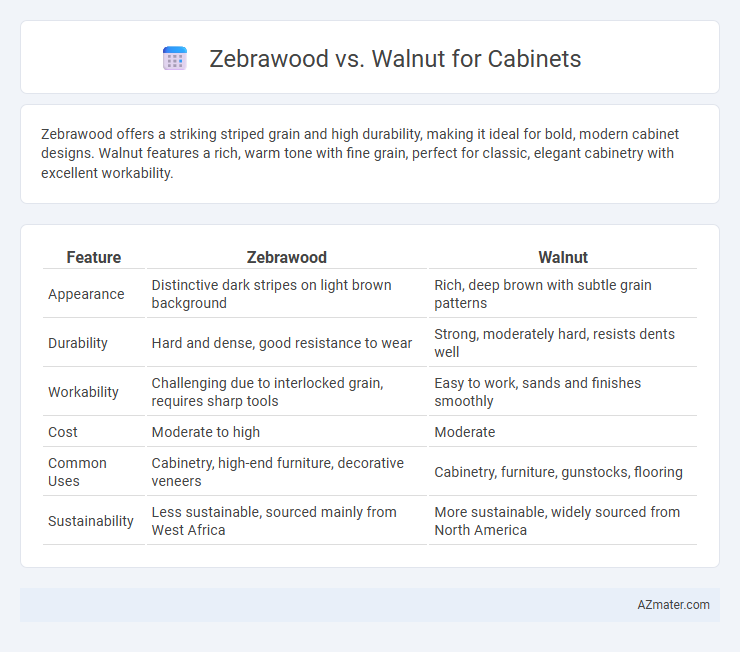Zebrawood offers a striking striped grain and high durability, making it ideal for bold, modern cabinet designs. Walnut features a rich, warm tone with fine grain, perfect for classic, elegant cabinetry with excellent workability.
Table of Comparison
| Feature | Zebrawood | Walnut |
|---|---|---|
| Appearance | Distinctive dark stripes on light brown background | Rich, deep brown with subtle grain patterns |
| Durability | Hard and dense, good resistance to wear | Strong, moderately hard, resists dents well |
| Workability | Challenging due to interlocked grain, requires sharp tools | Easy to work, sands and finishes smoothly |
| Cost | Moderate to high | Moderate |
| Common Uses | Cabinetry, high-end furniture, decorative veneers | Cabinetry, furniture, gunstocks, flooring |
| Sustainability | Less sustainable, sourced mainly from West Africa | More sustainable, widely sourced from North America |
Introduction to Zebrawood and Walnut
Zebrawood, known for its striking striped grain pattern and golden to dark brown hues, offers a bold and exotic aesthetic ideal for cabinet making. Walnut, prized for its rich, deep brown color with subtle purples and well-defined grain, provides a classic and timeless look that enhances cabinet durability and elegance. Both woods feature exceptional hardness and workability, making them preferred choices in high-end cabinetry.
Key Differences Between Zebrawood and Walnut
Zebrawood features distinctive dark stripes on a pale golden background, offering a bold, exotic aesthetic, while walnut has a rich, uniform brown color with subtle grain patterns, providing a classic, elegant appearance. Walnut is generally more durable and dense, making it better suited for high-traffic cabinetry, whereas zebrawood is lighter but may require extra care to prevent wear. Cost-wise, walnut tends to be more affordable and widely available compared to the rarer, premium-priced zebrawood, which can impact project budgeting.
Aesthetic Appeal: Grain Patterns and Colors
Zebrawood features bold, striking grain patterns with dark brown to black stripes contrasting against a golden or light brown background, creating a visually dynamic and exotic look for cabinets. Walnut offers rich, deep chocolate to purplish-brown hues with smoother, more uniform grain patterns that convey warmth and sophistication. Both woods enhance cabinet aesthetics, with Zebrawood providing eye-catching contrast and Walnut delivering timeless elegance.
Durability and Hardness Comparison
Zebrawood offers excellent durability with a Janka hardness rating around 1,380, making it highly resistant to dents and wear in cabinetry applications. Walnut, with a Janka hardness of approximately 1,010, is softer but still provides sufficient strength for everyday use, prized for its smooth finish and rich coloration. Both woods maintain durability over time, but Zebrawood's higher hardness delivers superior resistance to impact and scratches in high-traffic kitchen environments.
Workability and Ease of Crafting
Zebrawood offers moderate workability, with a coarse grain that can dull tools quickly, requiring sharp blades and careful handling during cabinet crafting. Walnut is favored for its exceptional ease of carving and shaping, featuring a fine, straight grain that machines smoothly and sands to a silky finish. Both woods provide durability, but walnut's superior workability makes it a preferred choice for intricate cabinet designs and detailed joinery.
Cost and Availability Factors
Zebrawood is generally more expensive and less readily available than walnut due to its exotic status and limited supply, which significantly impacts overall cabinet project costs. Walnut offers a more consistent availability and competitive pricing, making it a cost-effective choice for cabinetry without sacrificing durability or aesthetic appeal. Both woods provide distinct grain patterns, but budget-conscious projects often favor walnut for its balance of quality and accessibility.
Environmental Impact and Sustainability
Zebrawood and walnut differ significantly in environmental impact and sustainability; zebrawood is often sourced from West African forests where overharvesting threatens ecosystem balance, making it less environmentally sustainable compared to walnut. Walnut, especially when sourced from responsibly managed North American forests with certifications like FSC, offers a more sustainable option with lower deforestation risks and better forest regeneration practices. Choosing walnut cabinets supports sustainable forestry efforts and reduces the detrimental environmental effects commonly associated with exotic woods like zebrawood.
Maintenance and Longevity
Zebrawood cabinets require regular sealing due to their open grain, which can absorb moisture and stain, while walnut's dense, tight grain naturally resists wear and moisture, reducing maintenance needs. Walnut cabinets age gracefully, developing a rich patina over time that enhances longevity without frequent refinishing. Properly maintained walnut can last for decades in high-traffic areas, whereas zebrawood demands more frequent upkeep to preserve its vibrant striped appearance and structural integrity.
Best Applications in Cabinetry Design
Zebrawood's striking striped grain and durability make it ideal for accent panels or decorative cabinetry where visual impact is key, especially in contemporary or eclectic designs. Walnut offers rich, warm tones and a smooth texture, perfect for traditional or upscale cabinetry requiring elegance and long-lasting strength. Combining Zebrawood for feature areas with Walnut for structure ensures a balanced cabinet design marrying bold aesthetics with classic sophistication.
Final Verdict: Choosing Between Zebrawood and Walnut
Zebrawood offers striking, bold grain patterns ideal for unique, statement cabinetry, while walnut provides a rich, warm tone with a smooth, classic finish favored for timeless designs. Durable and stable, walnut generally suits high-traffic kitchen environments better, whereas zebrawood requires more maintenance due to its openness and grain complexity. Choosing between zebrawood and walnut depends on whether the preference is for dramatic aesthetics or enduring, traditional appeal in cabinet construction.

Infographic: Zebrawood vs Walnut for Cabinet
 azmater.com
azmater.com